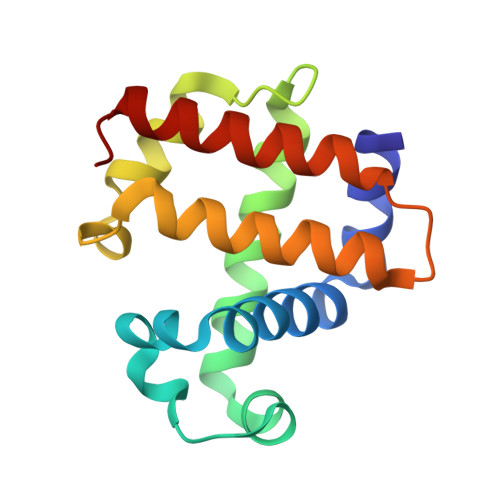How nature tunes isoenzyme activity in the multifunctional catalytic globin dehaloperoxidase from Amphitrite ornata.
Carey, L.M., Gavenko, R., Svistunenko, D.A., Ghiladi, R.A.(2018) Biochim Biophys Acta Proteins Proteom 1866: 230-241
- PubMed: 29128676
- DOI: https://doi.org/10.1016/j.bbapap.2017.11.004
- Primary Citation of Related Structures:
5V5J, 5V5Q, 5V5R - PubMed Abstract:
The coelomic hemoglobin of Amphitrite ornata, termed dehaloperoxidase (DHP), is the first known multifunctional catalytic globin to possess biologically-relevant peroxidase and peroxygenase activities. Although the two isoenzymes of DHP, A and B, differ in sequence by only 5 amino acids out of 137 residues, DHP B consistently exhibits a greater activity than isoenzyme A. To delineate the contributions of each amino acid substitution to the activity of either isoenzyme, the substitutions of the five amino acids were systematically investigated, individually and in combination, using 22 mutants. Biochemical assays and mechanistic studies demonstrated that the mutants that only contained the I9L substitution showed increased i) k cat values (peroxidase activity), ii) 5-Br-indole conversion and binding affinity (peroxygenase activity), and iii) rate of Compound ES formation (enzyme activation). Whereas the X-ray structures of the oxyferrous forms of DHP B (L9I) (1.96Å), DHP A (I9L) (1.20Å), and WT DHP B (1.81Å) showed no significant differences, UV-visible spectroscopy (A Soret /A 380 ratio) revealed that the I9L substitution increased the 5-coordinate high-spin heme population characterized by the "open" conformation (i.e., distal histidine swung out of the pocket), which likely favors substrate binding. The positioning of the distal histidine closer to the heme cofactor in the solution state also appears to facilitate activation of DHP via the Compound ES intermediate. Taken together, the studies undertaken here shed light on the structure-function relationship in dehaloperoxidase, but also help to establish the foundation for understanding how enzymatic activity can be tuned in isoenzymes of a multifunctional catalytic globin.
Organizational Affiliation:
Department of Chemistry, North Carolina State University, Raleigh, NC 27695-8204, United States.


















